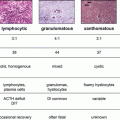June 2008
April 2010
June 2010
August 2010, LT4 1.0 μg/kg bw/day
December 2010, LT4 1.4 μg/kg bw/day
PRL, ng/ml (n.v. 3–20)
31
Basal: 41
+60’: 34
PRL recovery after IgG precipitation: 98 %
–
–
TSH, mU/l (n.v.: 0.4–4.0)
2.4
1.8
1.5
0.9
0.1
Free T4, pM (n.v.: 9–20)
–
9.0
8.6
11.4
16.3
Free T3, pM (n.v.: 4–8)
–
5.7
–
6.4
6.6
Anti-TPO Ab, kU/l (<20)
–
–
12
–
–
LDL-Cho, mg/dl (<150)
188
178
–
189
134
Hemochrome
Normal
–
Normal
Normal
–
The consultant started LT4 treatment for central hypothyroidism up to 1.0 μg/kg bw/day. On July 2010, the patient reported poor subjective improvement and mood depression. The TSH and free thyroid hormone values were in the normal range, the LDL-cholesterol levels were still elevated despite the dietary restrictions. The consultant confirmed the LT4 regimen explaining that other factors accounted for the persistence of the manifestations. After another 3 months without any improvement, the woman asked the advice of another consultant, who augmented the daily dose of LT4 up to 1.4 μg/kg on the basis of the symptoms and biochemical testing. Few weeks later, the patient observed the normalization of menses and the recovery of mood and physical performance, and she expressed the intention to restart the basketball training. The biochemical tests of December 2010 revealed a TSH value below but the FT4/FT3 levels at the mid of their normal range, the LDL-cholesterol was normal. The new consultant confirmed the current LT4 replacement.
Review of the Management of This Case
Diagnosis
This case describes a young woman with a central hypothyroidism and mild hyperprolactinemia. In this condition, the serum TSH screening alone cannot reveal the dysfunction of the hypothalamic–pituitary–thyroid axis, as TSH levels are most frequently normal [1–3]. Central hypothyroidism is presently known to account for about 1:1,000 hypothyroid patients, but is still probably underestimated and the Endocrinologists should always consider this possibility when hypothyroid manifestations coexist with biochemical alterations or clinical manifestations pointing to a pituitary origin. In this case, the first consultant initially gave little attention to the mild hyperprolactinemia and considered to check more appropriately and extensively thyroid function tests and PRL levels only 2 years after the start of symptoms. Indeed, the correct diagnosis could be suggested by the presence of a pituitary mass or history of pituitary disease, but a more careful recording of the personal history of this woman reporting the head trauma could have helped to anticipate the diagnosis. Indeed traumatic head injury or vascular accidents even of minor entity can account for several cases of central hypothyroidism previously classified as idiopathic. Most frequently, central hypothyroidism is combined with other pituitary hormone deficiencies that may mask the manifestations of a mild hypothyroid state, but their presence would support the central origin of thyroid dysfunction. In this case, the mild hypercholesterolemia was a finding supporting the recent onset of hypothyroidism, while the hyperprolactinemia, the absence of antithyroid autoantibodies and the normal findings at thyroid ultrasound were indeed pointing to the central origin.
Treatment
LT4 replacement therapy was correctly started. The initial daily dose was mistakenly judged sufficient by the consultant based on normal values of all thyroid function tests. Indeed, TSH determination is not a reliable marker of thyroid hormone action at the hypothalamic–pituitary level in patients with central hypothyroidism but the finding of unsuppressed TSH levels during thyroxine therapy is strongly suggestive of an insufficient regimen [1, 4–6]. Accordingly, LDL-cholesterol was still abnormal despite the dietary restriction. Due to the persistence of hypothyroid manifestations, the patients went to another consultant that correctly interpreted the biochemical results and augmented the daily dose of thyroxine. The regimen of 1.4 μg/kg bw was effective in restoring the wellbeing, normal menstrual activity, and physical performance in this sportswoman. The finding of suppressed TSH accompanied by thyroid hormone levels in the central part of normal range and the normalization of LDL-cholesterol were supporting the correct replacement.
Lessons Learned
Isolated central hypothyroidism can occur in a young sportswoman as a likely consequence of a mild head trauma. The diagnosis of central hypothyroidism should always be considered when hypothyroid-like manifestations coexist with low/normal TSH concentrations in the serum, but it should not completely discarded also in the presence of slightly elevated TSH, as in the cases with prevalent hypothalamic defect [1, 3]. Hyperprolactinemia, combined pituitary hormone deficiencies, or nonhormonal manifestations of a pituitary or hypothalamic mass should raise the suspect of a defective TSH secretion. However, nontumoral causes of pituitary dysfunction, including traumatic injuries, ictus, lymphocytic hypophysitis, other inflammatory diseases or genetic forms, should be kept in mind [1–3]. The finding of FT4 values below or at the lower limit of normal should then be correctly interpreted, particularly when these data are accompanied by an unexplained and persistent rise of cholesterol levels. The normal findings at thyroid ultrasound and the absence thyroid autoimmunity are also supporting the central origin of the disease.
Stay updated, free articles. Join our Telegram channel

Full access? Get Clinical Tree




